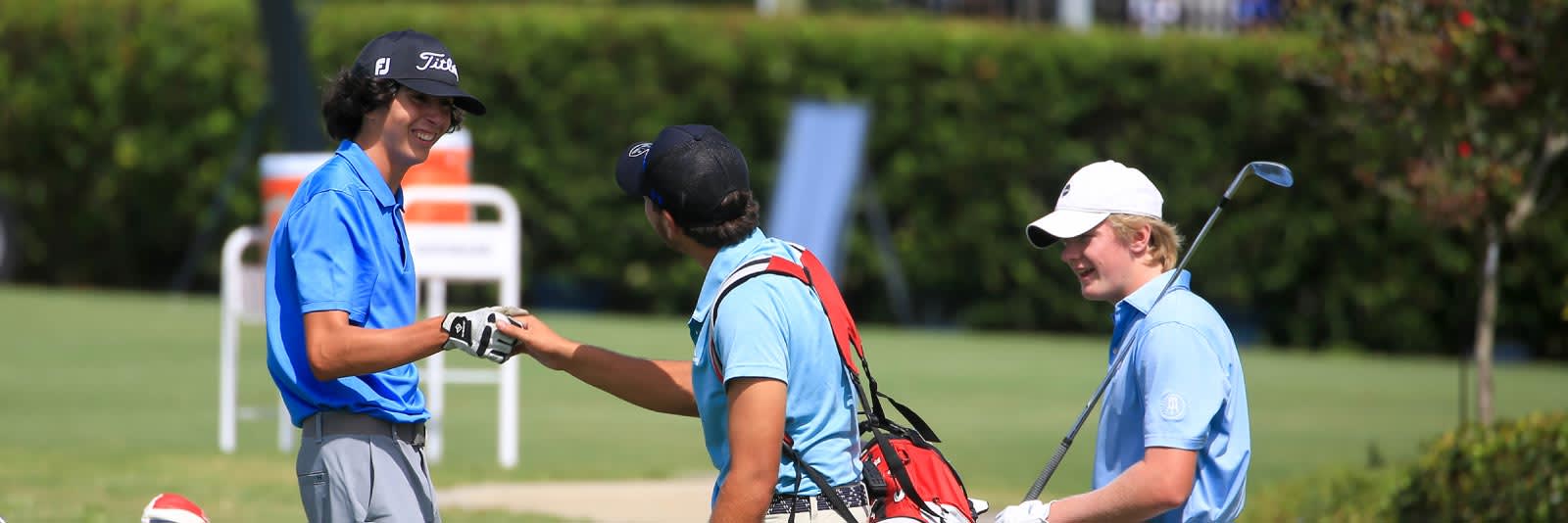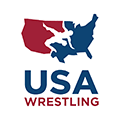How to Get Recruited for College Golf

If a student-athlete wants to be recruited by college golf coaches, they need qualifying scores, extensive tournament experience, solid grades and test scores and the mental toughness to overcome college course difficulty. To be successful, recruits need to research their best college fit and actively market themselves to these coaches by creating an online profile and swing video that highlights their athletic ability and leadership qualities. This section will answer the most common questions families have on how to get recruited for college golf.
Learn everything you need to know about college golf and golf recruiting.
Quick Links
How does the college golf recruiting process work?
You’ll quickly find that the path to college golf isn’t a linear, clear-cut process. You could be in the beginning phases with one college coach, while already establishing a sound relationship with another. Some moments are filled with excitement and evaluations, while others will feel as if you’re recruiting is on pause. But here’s the bottom line: if you put the work in—research schools, build a list of realistic colleges, create an online profile and swing video, get tournament exposure and actively reach out to coaches—you can find a competitive golf program that meets your academic needs and personal preferences.
From a coach’s perspective, here’s a quick overview of how they find student-athletes:
- Identify potential recruits: At any point in high school, coaches can send general materials, such as recruiting questionnaires, to student-athletes, and they usually send them out to a large number of freshmen and sophomores to gauge their interest in the program. It’s important to respond promptly to these materials if you receive them, but you can also visit an athletic program’s website to complete them on your own. These initial evaluations help college coaches build their list of interested prospects.
- Second, in-depth evaluations: This is the stage where most families think the recruiting process begins. However, athletes who’ve made it this far have already passed an initial evaluation and shown some interest in the school. At this point, coaches focus on ranking their prospects and narrowing down their list. National golf tournaments and rankings are essential for them to do this. They thoroughly analyze a recruit’s average golf scores and tournament experience and then make in-person evaluations whenever possible. They also evaluate online profiles and swing videos that student-athletes have emailed to them when they can’t see a prospect play in-person. Beyond athletics, they evaluate how each recruit’s grades and test scores measure up and exclude student-athletes who don’t meet their school’s expectations.
- Verbal offers and visits: After coaches have their list of ranked prospects, they extend offers and lock down verbal commitments. Top NCAA Division 1 and Division 2 golf programs make offers to student-athletes the summer after their sophomore year, while some coaches extend offers throughout junior and senior year, especially after test scores are available. Many recruits who are being seriously recruited will partake in unofficial and official visits during their junior year as well.
The most important thing student-athletes can do in their recruiting journey is be proactive. Don’t wait for coaches to contact you. Think about it this way—golf coaches are probably only recruiting a few student-athletes each year as their rosters tend to be smaller (about 10 players total). But in the beginning phases of their process, they’re compiling a list of hundreds—even thousands—student-athletes to consider. The best way to stand out among the competition is to actively reach out to them and show your personal interest in their program.
When do coaches start recruiting for golf?
The NCAA regulates when college golf coaches can reach out to student-athletes. Generally, contact begins June 15 after sophomore year. At this point, coaches can call, email, text and make verbal offers. NCAA Division 1 and top Division 2 programs usually set the pace for the golf recruiting timeline. Student-athletes may find that Division 3 and NAIA schools become more active during junior and senior year when ACT and SAT scores become available.
However, don’t read that as “recruiting starts after sophomore year.” Before this time, coaches build their list of potential prospects and evaluate athletes behind the scenes. That’s why the more proactive a student-athlete is in their recruiting journey—by researching schools, creating an online profile and swing video, and emailing coaches—the better their chances of getting recruited.
How to get noticed by college golf coaches
Recruiting can be an emotional, tedious roller coaster. But one thing that makes the ups and downs of the process easier is knowing what steps you should take to create a communication strategy and market yourself. Here are five things that all successful recruits do to secure a scholarship:
- Meet academic requirements. The NCAA Eligibility Center determines the academic eligibility and amateur status for all NCAA Division 1 and Division 2 athletes. Understand the requirements so you can stay on track. Plus, golf coaches are more likely to recruit student-athletes who excel academically.
- Know what requirements are needed in each division to compete. Every coach has a specific set of average golf scores and tournament experience that they’re looking for to better their program. You can visit the team’s roster to see how you qualify athletically.
- Attend multiple-day tournaments and become nationally ranked. When evaluating student-athletes, college coaches won’t consider scores from courses that are less than 6,600 yards. So they usually look at national tournaments and rankings to build their list of potential prospects. As you pick tournaments and events to attend, prioritize them based on course difficulty and zero in on ones that are at least 36 holes. Plus, these are the tournaments that factor into your national ranking most. You can visit Junior Golf Scoreboard to find tournaments that contribute toward your national ranking.
- Create an online profile. Golf coaches can’t see every recruit in-person. Even when they attend events, lengthy courses make it difficult to jump from recruit to recruit. That’s why it’s essential to make an online profile that showcases your golf scores, handicap, swing video, contact information and academic history.
- Contact coaches—and follow up. Student-athletes should never wait to simply “be discovered.” Instead, they need to proactively reach out to college coaches. Start by sending an introductory email that includes your online profile, swing video, academic information, outstanding athletic achievements and personal interest in the program. Then continue to follow up with noteworthy updates throughout the year.
What do college coaches look at when recruiting college golfers?
There’s actually an equation that college coaches use when determining which student-athletes to recruit. They find the average score of their best four college players and subtract it by two. So, for example, let’s say a team’s best scores from the top four golfers adds up to 300, making the average 75. In other words, that specific coach will want to recruit student-athletes who score a 73 or better. Of course, in some cases where the college is already extremely competitive, this equation isn’t always foolproof. But it’s a great way for a coach to determine how they can better their program. More importantly, it’s a useful tactic for student-athletes to help them determine where they can be competitive and earn a roster spot.
Furthermore, college coaches highly value tournament experience and national rankings over high school experience or achievements. The reason being that college courses are much more difficult than high school courses, which tend to only be 18 holes, and many national tournaments are at least 6,600 yards. Therefore, coaches really only focus on scores from multiple-day tournaments that are at least 36 holes.
Then, to conduct full evaluations of potential recruits, coaches overlay their scores with tournament experience, course difficulty and national rankings to see how athletes perform against top golfers in the country. They also look at a recruit’s “tournament score differential” by analyzing how they played each day. For example, they want to recruit athletes who can take and hold the lead or have the mental discipline to come back from an off day.
The easiest way to determine a coach’s recruiting needs is by looking at their current roster. What are the athlete’s average scores and tournament experience? Taking time to study a team’s roster can provide insight into a coach’s recruiting strategy and help you gain a competitive edge.
See the recruiting golf guidelines for every division.
Do golf coaches care about academics?
College coaches for all sports prioritize recruits who have strong grades and high test scores, even more so in men’s golf. The average college golf team is 10 players and coaches typically only need to recruit a few student-athletes each year, so they tend to be selective. Put it this way—if college coaches are looking at two recruits with similar golf stats and experience, they’re going to pick the student-athlete who has a solid academic background. When they see a focused athlete who works hard in the classroom, they assume they’ll have an easier college transition. Plus, this recruit can qualify for more academic aid, easing the burden on the coach to provide athletic funding. Bottom line: your grades matter just as much as your golf game.
Attend golf camps and tournaments to gain exposure to college coaches
Individual tournament play is the number one factor college coaches consider when making their roster and scholarship decisions. As a recruit, you need to know which tournaments attract the schools on your target list and what scores will garner interest from that coach. In general, college coaches want to see average scores from multiple-day events that are at least 36-holes. They typically overlook any results that are from less than 6,600 yards. One of the best ways to explore independent tournaments is by searching on Junior Golf Scoreboard. Any of these events will contribute to your national ranking, which will improve your college coach interest as well.
What national golf tournaments should I compete in?
Competing at the national level is one the best ways junior golfers can garner coach interest. Men’s golf coaches typically overlook high school competition and turn their attention to these events instead. More importantly, competing nationally gives student-athletes a chance to play in front of college coaches and improve their national ranking, while seeing how they stack up against top talent. Student-athletes have a few options to identify national golf tournament opportunities:
- National Golf Tours: The American Junior Golf Association (AJGA), Future Collegians World Tour (FCWT) and the International Junior Golf Tour (IJGT) offer multiple-day competitions across the country and attract top recruits and college programs alike. Though, they can be expensive and require a membership to attend.
- Junior Golf Scoreboard: A quick search on Junior Golf Scoreboard will populate a list of verified multiple-day tournaments that can contribute to your national ranking. While Florida, Georgia, South Carolina, Texas, California and Arizona host several competitive tours, there are more than 2,000 tournaments on Junior Golf Scoreboard.
- United States Golf Association (USGA) Championships. The most prestigious junior and amateur golf competitions are conducted by the United States Golf Association (USGA). Student-athletes must pass a rigorous qualifying process for these events and only the best junior golfers in the country actually do.
What to include in your golf recruiting video
Creating a golf swing video can be a highly effective way of establishing a relationship with a college coach. They give coaches an opportunity to learn more about you as a player without having to travel to see you in person. This is key in men’s golf recruiting as many coaches—especially at the NCAA Division 2 and Division 3 levels—don’t have the budget to see all the recruits on their list compete in person. And even when they do attend tournaments, the length of the course can make it difficult to jump from golfer to golfer.
Your video should capture a wide variety of swings and club selections from different parts of the course, including:
- 2 or 3 swings with a short iron/wedge from a “down the line” angle and a “face on” angle
- 2 or 3 swings with a mid/long iron from a “down the line” angle and a “face on” angle
- 2 or 3 swings with a driver from a “down the line” angle and a “face on” angle
- Several chips, pitches and bunker shots from both angles
- Short, medium and long putts from both angles
- Straight putts from five to 10 feet from both angles
All your swings should be at a normal speed and if done correctly, your video will fall around 10 minutes long. There’s no need to add music, or any audio really, to your video.
One of the best ways to get on a college coach’s radar is by sending them a golf recruiting video. For players who may not have new footage from tournaments or camps, a golf skills video is key for showing coaches your athleticism and technical ability. In the video below, former D1 golfer Abby Phillips shares her tips for creating a men’s golf skills video that will get you noticed, like:
- When and where to film (even if you don’t have access to a golf course!)
- What angles to include (down the line and face-on footage are primarily what coaches want to see)
- How to film (a phone camera is fine) and how long your video should be (2-3 minutes max)
- What details to include, like clubs you’re hitting, yardage that you hit and how many swings per club you should have
Researching golf schools
There are a lot of factors to consider when making the college decision. Student-athletes should build a list of target schools that meet their academic expectations, athletic ability and personal preferences. But where’s the best place to start?
- First, check out the differences among the division levels. Pick a couple of schools and visit the team’s roster online to learn more about the athletes’ golf scores, tournament experience and where they were recruited from. You want to make sure that you’re the right athletic fit and have a chance at getting recruited.
- You also want to think about the training schedule, financial aid opportunities and time commitments (especially in the offseason) at every division level when considering which is best for you. For example, at most schools, only the top five golfers on each team will travel to tournaments and compete. If playing is important to you, then you’ll want to consider what it would take to make the travel team at a specific college.
- Additionally, you can’t overlook academic requirements—having competitive test scores and grades will help you secure a roster spot. Men’s golf coaches are extremely selective when it comes to academics. They want to recruit student-athletes who will excel in the classroom.
Once you have a good grasp on the athletic and academic landscape, you can start to add schools to your target list. NCSA has developed a list of the top colleges for men’s golf, which is based on a number of factors, including cost, academics, size and location, to help student-athletes identify schools.
When is the best time to contact college golf coaches?
It depends—you don’t want to wait too long to contact college coaches, but you also don’t want to reach out to them before ready. The first thing you should do is research schools and understand the average scores and tournament experience needed to play at each one, as well as the GPA and test scores required to be admitted. Once you feel confident that you have a list of realistic programs in mind, you can start to email college coaches your online profile and swing video.
The top golf programs in the country will make verbal offers to recruits during the summer after their sophomore year, so if you’re looking to play at an NCAA Division 1 or Division 2 school, you’ll need to establish relationships with coaches during your sophomore year. Typically, the second half of sophomore year through the end of junior year is when recruits want to be at their best golf game and proactively reaching out to college coaches. The earlier you start contacting college coaches, the more opportunity you’ll have. That being said, several coaches, including NCAA Division 3, NAIA and NJCAA coaches, continue to recruit into senior year.
What’s my high school coach’s role in the recruiting process?
You don’t have to tackle your recruiting process alone. Your swing coach or high school coach is there to support you along the way. From recommendations to video assistance, here are a few scenarios where they’d be especially helpful:
- When you need a character reference. Men’s golf coaches want to learn as much as they can about their top recruits’ talent, including their leadership qualities and attitude. So, they call the recruit’s private coach, swing coach or high school coach to get a better understanding of the athlete’s mental toughness, work ethic and behavior both on and off the course. That’s why it’s important to keep your high school and private coach in the loop on which colleges are on your target list.
- When you want honest feedback. Your coaches may be the best people to turn to when you’re looking for feedback during your college search. You can use their expertise and insight to create a college list of realistic programs—based on your talent and grades—where you can be a real contender.
- When you need to create a swing video. Don’t hesitate to ask your swing coach or private coach for help when creating a highlight film. The truth is—they’ve probably done this before.
















